Stalin's Terror: Political and Economic Strategies in Soviet Russia
VerifiedAdded on 2023/06/15
|17
|5278
|247
Essay
AI Summary
This essay delves into the strategies employed by Stalin to consolidate his power in the Soviet Union, focusing on political, economic, and social gains. It highlights the extreme oppression and political purges, such as the 'Great Purge' and the Moscow Trials, aimed at eliminating any opposition. The economic policies, particularly the suppression of the kulaks and collectivization, are examined as means to stabilize the economy and eliminate potential economic rivals. The essay also touches upon the social implications of Stalin's policies, emphasizing the use of terror to silence dissent and maintain control, ultimately establishing Stalin as the supreme leader of the USSR. Desklib offers additional resources and solved assignments for students seeking to understand this period.
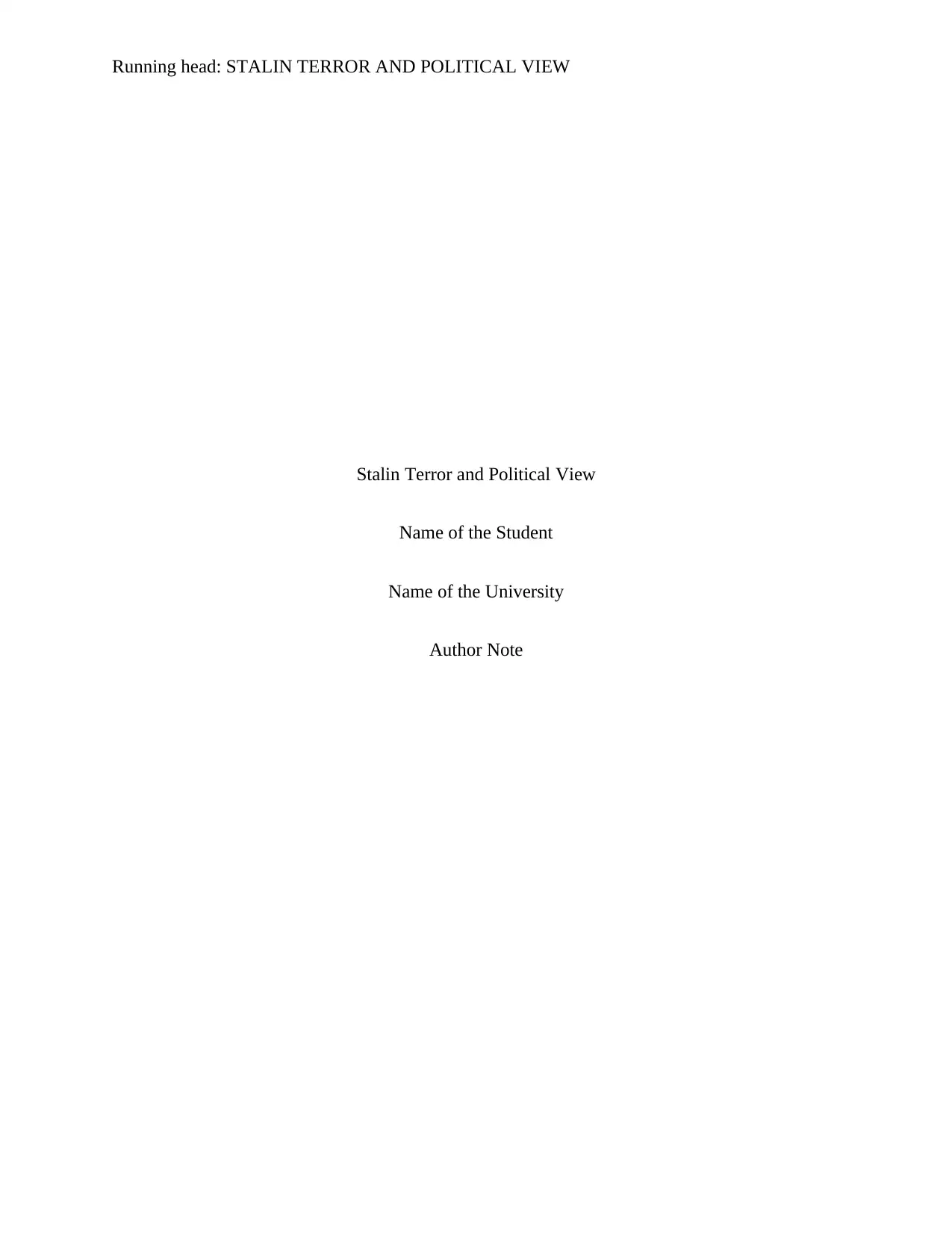
Running head: STALIN TERROR AND POLITICAL VIEW
Stalin Terror and Political View
Name of the Student
Name of the University
Author Note
Stalin Terror and Political View
Name of the Student
Name of the University
Author Note
Paraphrase This Document
Need a fresh take? Get an instant paraphrase of this document with our AI Paraphraser
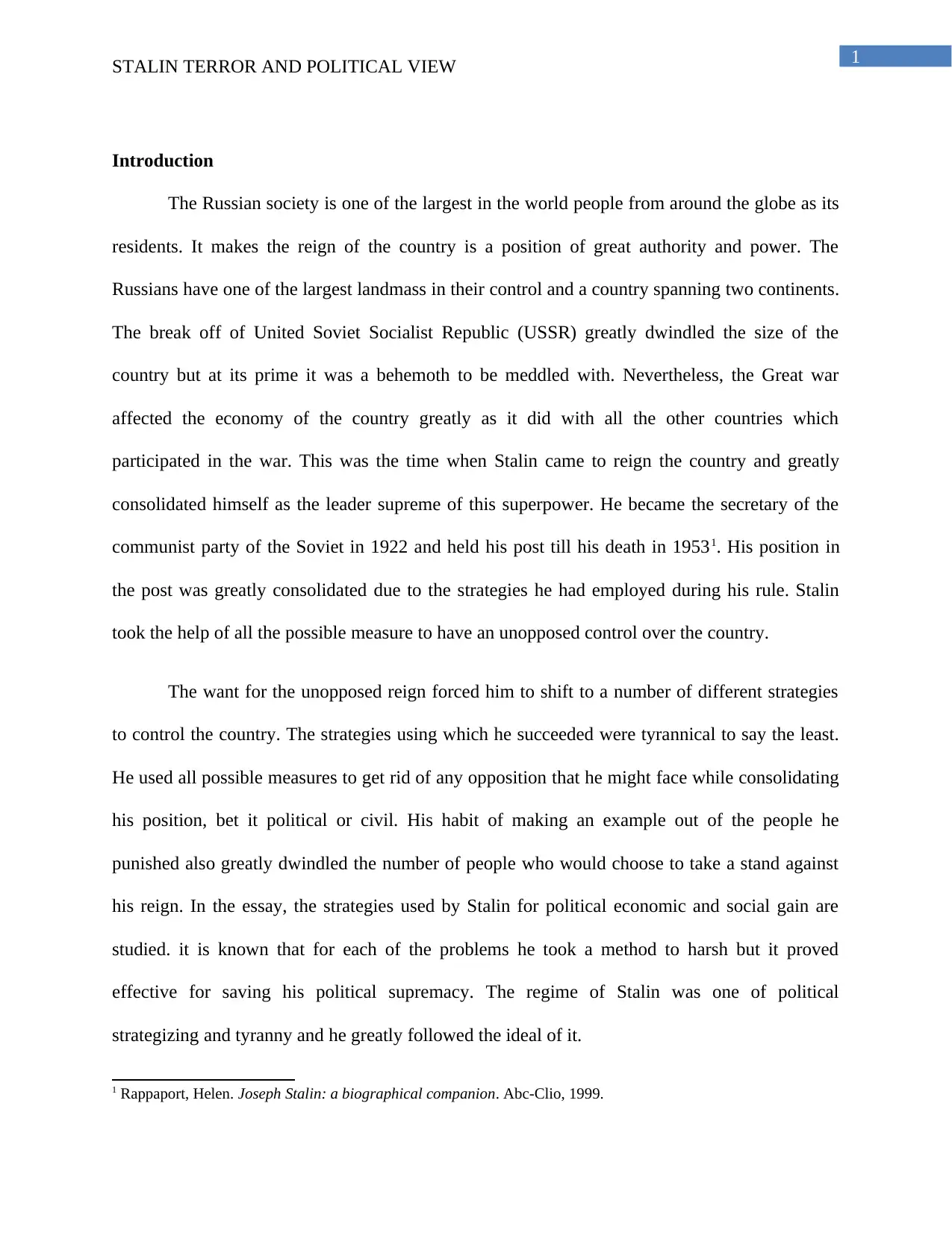
1
STALIN TERROR AND POLITICAL VIEW
Introduction
The Russian society is one of the largest in the world people from around the globe as its
residents. It makes the reign of the country is a position of great authority and power. The
Russians have one of the largest landmass in their control and a country spanning two continents.
The break off of United Soviet Socialist Republic (USSR) greatly dwindled the size of the
country but at its prime it was a behemoth to be meddled with. Nevertheless, the Great war
affected the economy of the country greatly as it did with all the other countries which
participated in the war. This was the time when Stalin came to reign the country and greatly
consolidated himself as the leader supreme of this superpower. He became the secretary of the
communist party of the Soviet in 1922 and held his post till his death in 19531. His position in
the post was greatly consolidated due to the strategies he had employed during his rule. Stalin
took the help of all the possible measure to have an unopposed control over the country.
The want for the unopposed reign forced him to shift to a number of different strategies
to control the country. The strategies using which he succeeded were tyrannical to say the least.
He used all possible measures to get rid of any opposition that he might face while consolidating
his position, bet it political or civil. His habit of making an example out of the people he
punished also greatly dwindled the number of people who would choose to take a stand against
his reign. In the essay, the strategies used by Stalin for political economic and social gain are
studied. it is known that for each of the problems he took a method to harsh but it proved
effective for saving his political supremacy. The regime of Stalin was one of political
strategizing and tyranny and he greatly followed the ideal of it.
1 Rappaport, Helen. Joseph Stalin: a biographical companion. Abc-Clio, 1999.
STALIN TERROR AND POLITICAL VIEW
Introduction
The Russian society is one of the largest in the world people from around the globe as its
residents. It makes the reign of the country is a position of great authority and power. The
Russians have one of the largest landmass in their control and a country spanning two continents.
The break off of United Soviet Socialist Republic (USSR) greatly dwindled the size of the
country but at its prime it was a behemoth to be meddled with. Nevertheless, the Great war
affected the economy of the country greatly as it did with all the other countries which
participated in the war. This was the time when Stalin came to reign the country and greatly
consolidated himself as the leader supreme of this superpower. He became the secretary of the
communist party of the Soviet in 1922 and held his post till his death in 19531. His position in
the post was greatly consolidated due to the strategies he had employed during his rule. Stalin
took the help of all the possible measure to have an unopposed control over the country.
The want for the unopposed reign forced him to shift to a number of different strategies
to control the country. The strategies using which he succeeded were tyrannical to say the least.
He used all possible measures to get rid of any opposition that he might face while consolidating
his position, bet it political or civil. His habit of making an example out of the people he
punished also greatly dwindled the number of people who would choose to take a stand against
his reign. In the essay, the strategies used by Stalin for political economic and social gain are
studied. it is known that for each of the problems he took a method to harsh but it proved
effective for saving his political supremacy. The regime of Stalin was one of political
strategizing and tyranny and he greatly followed the ideal of it.
1 Rappaport, Helen. Joseph Stalin: a biographical companion. Abc-Clio, 1999.
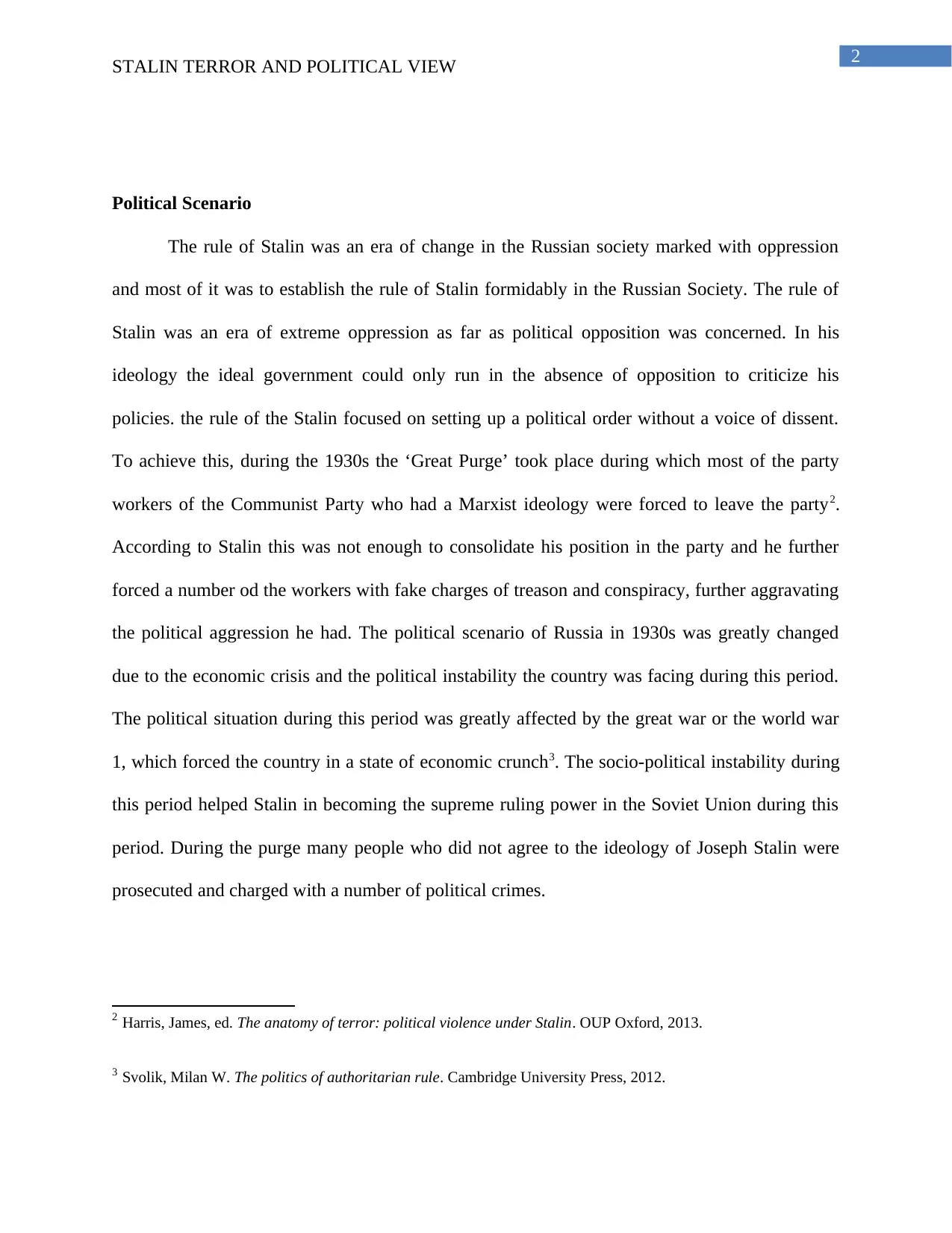
2
STALIN TERROR AND POLITICAL VIEW
Political Scenario
The rule of Stalin was an era of change in the Russian society marked with oppression
and most of it was to establish the rule of Stalin formidably in the Russian Society. The rule of
Stalin was an era of extreme oppression as far as political opposition was concerned. In his
ideology the ideal government could only run in the absence of opposition to criticize his
policies. the rule of the Stalin focused on setting up a political order without a voice of dissent.
To achieve this, during the 1930s the ‘Great Purge’ took place during which most of the party
workers of the Communist Party who had a Marxist ideology were forced to leave the party2.
According to Stalin this was not enough to consolidate his position in the party and he further
forced a number od the workers with fake charges of treason and conspiracy, further aggravating
the political aggression he had. The political scenario of Russia in 1930s was greatly changed
due to the economic crisis and the political instability the country was facing during this period.
The political situation during this period was greatly affected by the great war or the world war
1, which forced the country in a state of economic crunch3. The socio-political instability during
this period helped Stalin in becoming the supreme ruling power in the Soviet Union during this
period. During the purge many people who did not agree to the ideology of Joseph Stalin were
prosecuted and charged with a number of political crimes.
2 Harris, James, ed. The anatomy of terror: political violence under Stalin. OUP Oxford, 2013.
3 Svolik, Milan W. The politics of authoritarian rule. Cambridge University Press, 2012.
STALIN TERROR AND POLITICAL VIEW
Political Scenario
The rule of Stalin was an era of change in the Russian society marked with oppression
and most of it was to establish the rule of Stalin formidably in the Russian Society. The rule of
Stalin was an era of extreme oppression as far as political opposition was concerned. In his
ideology the ideal government could only run in the absence of opposition to criticize his
policies. the rule of the Stalin focused on setting up a political order without a voice of dissent.
To achieve this, during the 1930s the ‘Great Purge’ took place during which most of the party
workers of the Communist Party who had a Marxist ideology were forced to leave the party2.
According to Stalin this was not enough to consolidate his position in the party and he further
forced a number od the workers with fake charges of treason and conspiracy, further aggravating
the political aggression he had. The political scenario of Russia in 1930s was greatly changed
due to the economic crisis and the political instability the country was facing during this period.
The political situation during this period was greatly affected by the great war or the world war
1, which forced the country in a state of economic crunch3. The socio-political instability during
this period helped Stalin in becoming the supreme ruling power in the Soviet Union during this
period. During the purge many people who did not agree to the ideology of Joseph Stalin were
prosecuted and charged with a number of political crimes.
2 Harris, James, ed. The anatomy of terror: political violence under Stalin. OUP Oxford, 2013.
3 Svolik, Milan W. The politics of authoritarian rule. Cambridge University Press, 2012.
⊘ This is a preview!⊘
Do you want full access?
Subscribe today to unlock all pages.

Trusted by 1+ million students worldwide
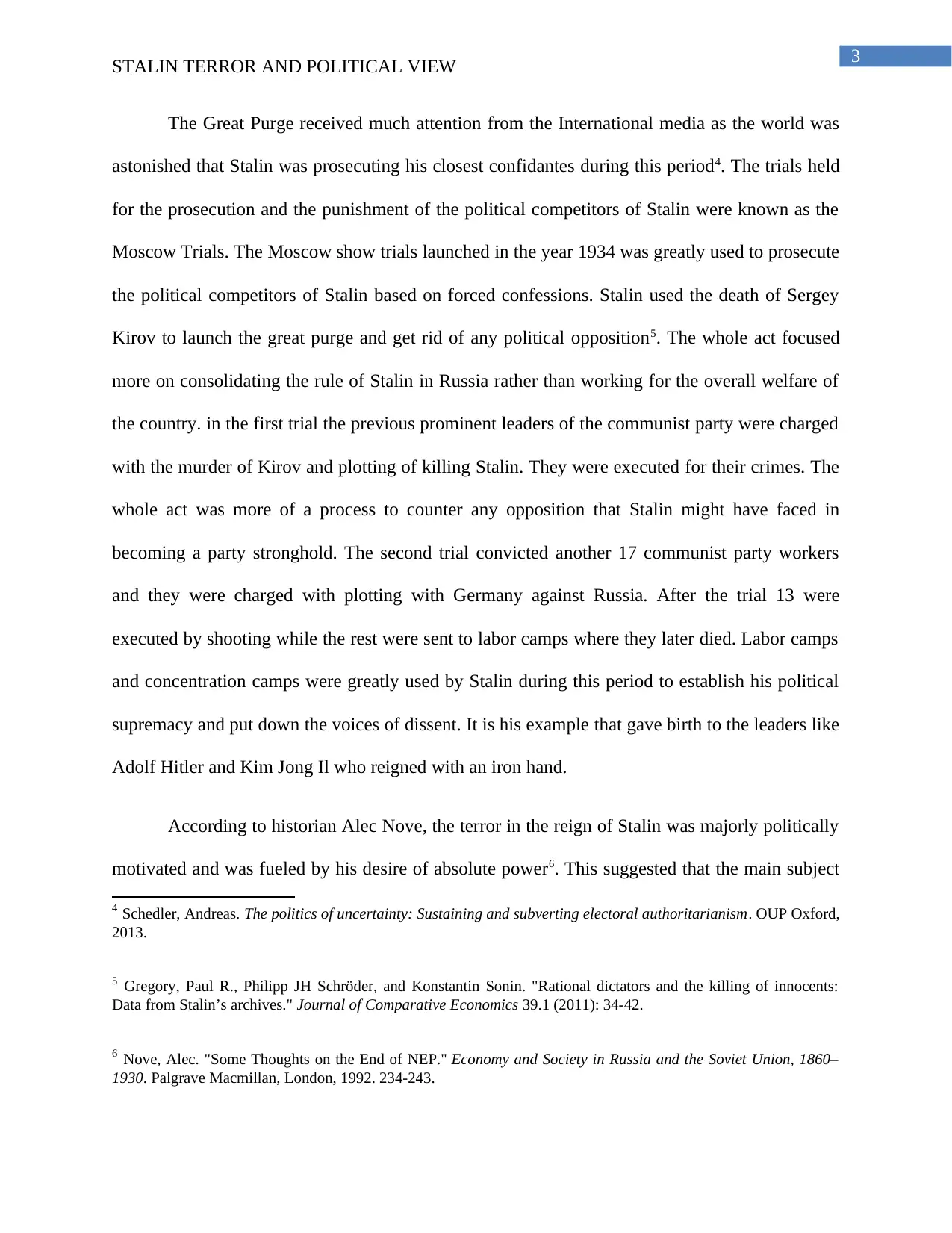
3
STALIN TERROR AND POLITICAL VIEW
The Great Purge received much attention from the International media as the world was
astonished that Stalin was prosecuting his closest confidantes during this period4. The trials held
for the prosecution and the punishment of the political competitors of Stalin were known as the
Moscow Trials. The Moscow show trials launched in the year 1934 was greatly used to prosecute
the political competitors of Stalin based on forced confessions. Stalin used the death of Sergey
Kirov to launch the great purge and get rid of any political opposition5. The whole act focused
more on consolidating the rule of Stalin in Russia rather than working for the overall welfare of
the country. in the first trial the previous prominent leaders of the communist party were charged
with the murder of Kirov and plotting of killing Stalin. They were executed for their crimes. The
whole act was more of a process to counter any opposition that Stalin might have faced in
becoming a party stronghold. The second trial convicted another 17 communist party workers
and they were charged with plotting with Germany against Russia. After the trial 13 were
executed by shooting while the rest were sent to labor camps where they later died. Labor camps
and concentration camps were greatly used by Stalin during this period to establish his political
supremacy and put down the voices of dissent. It is his example that gave birth to the leaders like
Adolf Hitler and Kim Jong Il who reigned with an iron hand.
According to historian Alec Nove, the terror in the reign of Stalin was majorly politically
motivated and was fueled by his desire of absolute power6. This suggested that the main subject
4 Schedler, Andreas. The politics of uncertainty: Sustaining and subverting electoral authoritarianism. OUP Oxford,
2013.
5 Gregory, Paul R., Philipp JH Schröder, and Konstantin Sonin. "Rational dictators and the killing of innocents:
Data from Stalin’s archives." Journal of Comparative Economics 39.1 (2011): 34-42.
6 Nove, Alec. "Some Thoughts on the End of NEP." Economy and Society in Russia and the Soviet Union, 1860–
1930. Palgrave Macmillan, London, 1992. 234-243.
STALIN TERROR AND POLITICAL VIEW
The Great Purge received much attention from the International media as the world was
astonished that Stalin was prosecuting his closest confidantes during this period4. The trials held
for the prosecution and the punishment of the political competitors of Stalin were known as the
Moscow Trials. The Moscow show trials launched in the year 1934 was greatly used to prosecute
the political competitors of Stalin based on forced confessions. Stalin used the death of Sergey
Kirov to launch the great purge and get rid of any political opposition5. The whole act focused
more on consolidating the rule of Stalin in Russia rather than working for the overall welfare of
the country. in the first trial the previous prominent leaders of the communist party were charged
with the murder of Kirov and plotting of killing Stalin. They were executed for their crimes. The
whole act was more of a process to counter any opposition that Stalin might have faced in
becoming a party stronghold. The second trial convicted another 17 communist party workers
and they were charged with plotting with Germany against Russia. After the trial 13 were
executed by shooting while the rest were sent to labor camps where they later died. Labor camps
and concentration camps were greatly used by Stalin during this period to establish his political
supremacy and put down the voices of dissent. It is his example that gave birth to the leaders like
Adolf Hitler and Kim Jong Il who reigned with an iron hand.
According to historian Alec Nove, the terror in the reign of Stalin was majorly politically
motivated and was fueled by his desire of absolute power6. This suggested that the main subject
4 Schedler, Andreas. The politics of uncertainty: Sustaining and subverting electoral authoritarianism. OUP Oxford,
2013.
5 Gregory, Paul R., Philipp JH Schröder, and Konstantin Sonin. "Rational dictators and the killing of innocents:
Data from Stalin’s archives." Journal of Comparative Economics 39.1 (2011): 34-42.
6 Nove, Alec. "Some Thoughts on the End of NEP." Economy and Society in Russia and the Soviet Union, 1860–
1930. Palgrave Macmillan, London, 1992. 234-243.
Paraphrase This Document
Need a fresh take? Get an instant paraphrase of this document with our AI Paraphraser
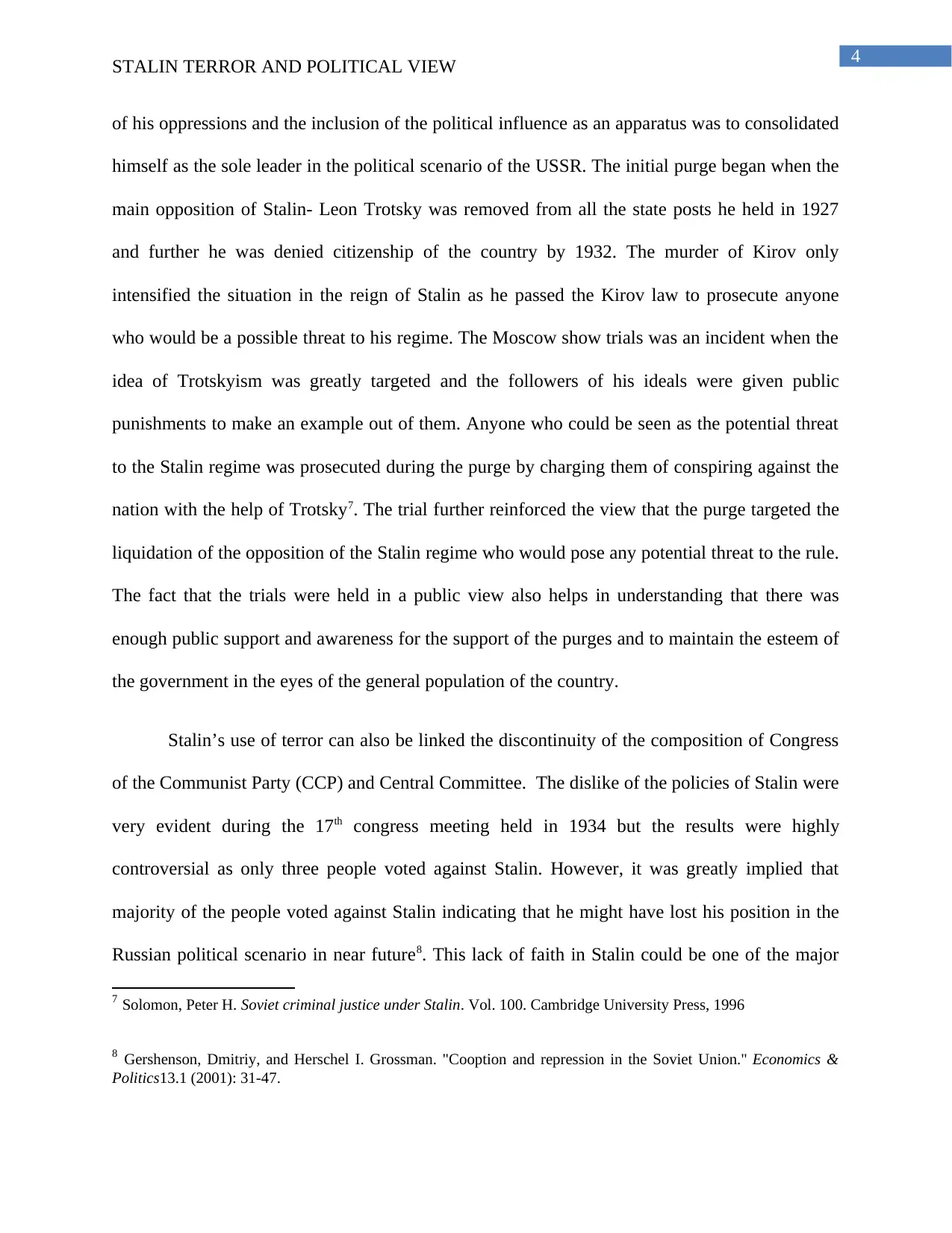
4
STALIN TERROR AND POLITICAL VIEW
of his oppressions and the inclusion of the political influence as an apparatus was to consolidated
himself as the sole leader in the political scenario of the USSR. The initial purge began when the
main opposition of Stalin- Leon Trotsky was removed from all the state posts he held in 1927
and further he was denied citizenship of the country by 1932. The murder of Kirov only
intensified the situation in the reign of Stalin as he passed the Kirov law to prosecute anyone
who would be a possible threat to his regime. The Moscow show trials was an incident when the
idea of Trotskyism was greatly targeted and the followers of his ideals were given public
punishments to make an example out of them. Anyone who could be seen as the potential threat
to the Stalin regime was prosecuted during the purge by charging them of conspiring against the
nation with the help of Trotsky7. The trial further reinforced the view that the purge targeted the
liquidation of the opposition of the Stalin regime who would pose any potential threat to the rule.
The fact that the trials were held in a public view also helps in understanding that there was
enough public support and awareness for the support of the purges and to maintain the esteem of
the government in the eyes of the general population of the country.
Stalin’s use of terror can also be linked the discontinuity of the composition of Congress
of the Communist Party (CCP) and Central Committee. The dislike of the policies of Stalin were
very evident during the 17th congress meeting held in 1934 but the results were highly
controversial as only three people voted against Stalin. However, it was greatly implied that
majority of the people voted against Stalin indicating that he might have lost his position in the
Russian political scenario in near future8. This lack of faith in Stalin could be one of the major
7 Solomon, Peter H. Soviet criminal justice under Stalin. Vol. 100. Cambridge University Press, 1996
8 Gershenson, Dmitriy, and Herschel I. Grossman. "Cooption and repression in the Soviet Union." Economics &
Politics13.1 (2001): 31-47.
STALIN TERROR AND POLITICAL VIEW
of his oppressions and the inclusion of the political influence as an apparatus was to consolidated
himself as the sole leader in the political scenario of the USSR. The initial purge began when the
main opposition of Stalin- Leon Trotsky was removed from all the state posts he held in 1927
and further he was denied citizenship of the country by 1932. The murder of Kirov only
intensified the situation in the reign of Stalin as he passed the Kirov law to prosecute anyone
who would be a possible threat to his regime. The Moscow show trials was an incident when the
idea of Trotskyism was greatly targeted and the followers of his ideals were given public
punishments to make an example out of them. Anyone who could be seen as the potential threat
to the Stalin regime was prosecuted during the purge by charging them of conspiring against the
nation with the help of Trotsky7. The trial further reinforced the view that the purge targeted the
liquidation of the opposition of the Stalin regime who would pose any potential threat to the rule.
The fact that the trials were held in a public view also helps in understanding that there was
enough public support and awareness for the support of the purges and to maintain the esteem of
the government in the eyes of the general population of the country.
Stalin’s use of terror can also be linked the discontinuity of the composition of Congress
of the Communist Party (CCP) and Central Committee. The dislike of the policies of Stalin were
very evident during the 17th congress meeting held in 1934 but the results were highly
controversial as only three people voted against Stalin. However, it was greatly implied that
majority of the people voted against Stalin indicating that he might have lost his position in the
Russian political scenario in near future8. This lack of faith in Stalin could be one of the major
7 Solomon, Peter H. Soviet criminal justice under Stalin. Vol. 100. Cambridge University Press, 1996
8 Gershenson, Dmitriy, and Herschel I. Grossman. "Cooption and repression in the Soviet Union." Economics &
Politics13.1 (2001): 31-47.
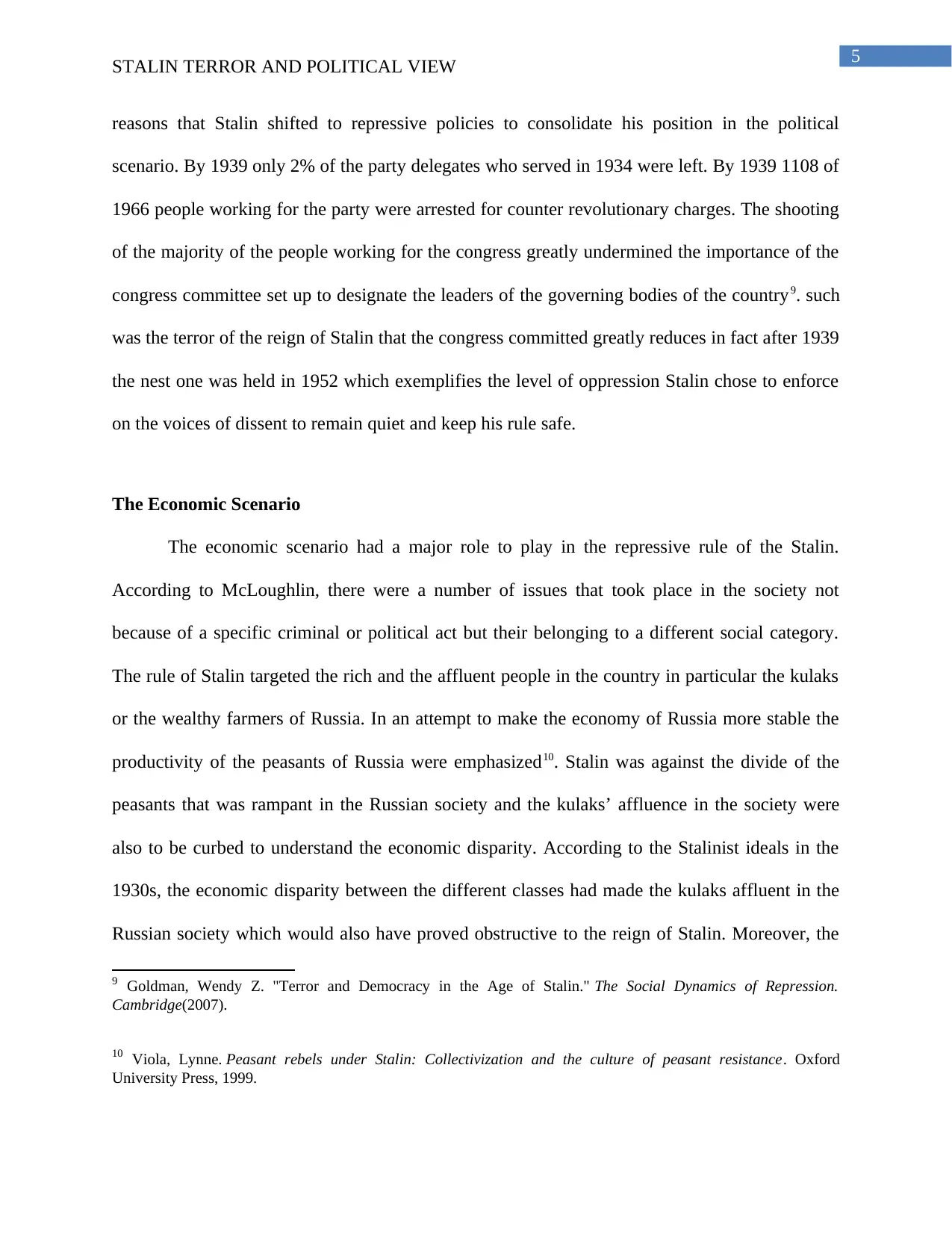
5
STALIN TERROR AND POLITICAL VIEW
reasons that Stalin shifted to repressive policies to consolidate his position in the political
scenario. By 1939 only 2% of the party delegates who served in 1934 were left. By 1939 1108 of
1966 people working for the party were arrested for counter revolutionary charges. The shooting
of the majority of the people working for the congress greatly undermined the importance of the
congress committee set up to designate the leaders of the governing bodies of the country9. such
was the terror of the reign of Stalin that the congress committed greatly reduces in fact after 1939
the nest one was held in 1952 which exemplifies the level of oppression Stalin chose to enforce
on the voices of dissent to remain quiet and keep his rule safe.
The Economic Scenario
The economic scenario had a major role to play in the repressive rule of the Stalin.
According to McLoughlin, there were a number of issues that took place in the society not
because of a specific criminal or political act but their belonging to a different social category.
The rule of Stalin targeted the rich and the affluent people in the country in particular the kulaks
or the wealthy farmers of Russia. In an attempt to make the economy of Russia more stable the
productivity of the peasants of Russia were emphasized10. Stalin was against the divide of the
peasants that was rampant in the Russian society and the kulaks’ affluence in the society were
also to be curbed to understand the economic disparity. According to the Stalinist ideals in the
1930s, the economic disparity between the different classes had made the kulaks affluent in the
Russian society which would also have proved obstructive to the reign of Stalin. Moreover, the
9 Goldman, Wendy Z. "Terror and Democracy in the Age of Stalin." The Social Dynamics of Repression.
Cambridge(2007).
10 Viola, Lynne. Peasant rebels under Stalin: Collectivization and the culture of peasant resistance. Oxford
University Press, 1999.
STALIN TERROR AND POLITICAL VIEW
reasons that Stalin shifted to repressive policies to consolidate his position in the political
scenario. By 1939 only 2% of the party delegates who served in 1934 were left. By 1939 1108 of
1966 people working for the party were arrested for counter revolutionary charges. The shooting
of the majority of the people working for the congress greatly undermined the importance of the
congress committee set up to designate the leaders of the governing bodies of the country9. such
was the terror of the reign of Stalin that the congress committed greatly reduces in fact after 1939
the nest one was held in 1952 which exemplifies the level of oppression Stalin chose to enforce
on the voices of dissent to remain quiet and keep his rule safe.
The Economic Scenario
The economic scenario had a major role to play in the repressive rule of the Stalin.
According to McLoughlin, there were a number of issues that took place in the society not
because of a specific criminal or political act but their belonging to a different social category.
The rule of Stalin targeted the rich and the affluent people in the country in particular the kulaks
or the wealthy farmers of Russia. In an attempt to make the economy of Russia more stable the
productivity of the peasants of Russia were emphasized10. Stalin was against the divide of the
peasants that was rampant in the Russian society and the kulaks’ affluence in the society were
also to be curbed to understand the economic disparity. According to the Stalinist ideals in the
1930s, the economic disparity between the different classes had made the kulaks affluent in the
Russian society which would also have proved obstructive to the reign of Stalin. Moreover, the
9 Goldman, Wendy Z. "Terror and Democracy in the Age of Stalin." The Social Dynamics of Repression.
Cambridge(2007).
10 Viola, Lynne. Peasant rebels under Stalin: Collectivization and the culture of peasant resistance. Oxford
University Press, 1999.
⊘ This is a preview!⊘
Do you want full access?
Subscribe today to unlock all pages.

Trusted by 1+ million students worldwide
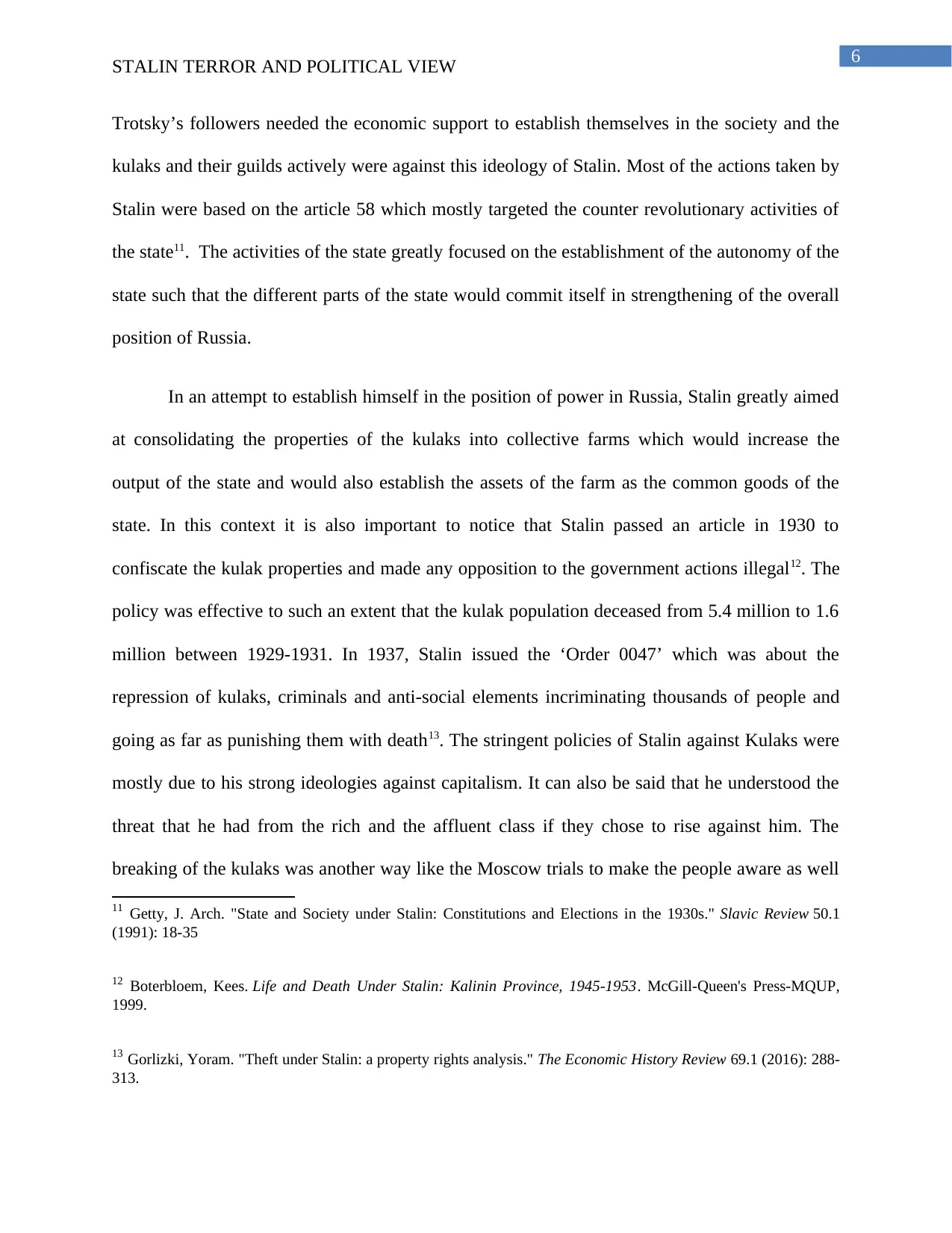
6
STALIN TERROR AND POLITICAL VIEW
Trotsky’s followers needed the economic support to establish themselves in the society and the
kulaks and their guilds actively were against this ideology of Stalin. Most of the actions taken by
Stalin were based on the article 58 which mostly targeted the counter revolutionary activities of
the state11. The activities of the state greatly focused on the establishment of the autonomy of the
state such that the different parts of the state would commit itself in strengthening of the overall
position of Russia.
In an attempt to establish himself in the position of power in Russia, Stalin greatly aimed
at consolidating the properties of the kulaks into collective farms which would increase the
output of the state and would also establish the assets of the farm as the common goods of the
state. In this context it is also important to notice that Stalin passed an article in 1930 to
confiscate the kulak properties and made any opposition to the government actions illegal12. The
policy was effective to such an extent that the kulak population deceased from 5.4 million to 1.6
million between 1929-1931. In 1937, Stalin issued the ‘Order 0047’ which was about the
repression of kulaks, criminals and anti-social elements incriminating thousands of people and
going as far as punishing them with death13. The stringent policies of Stalin against Kulaks were
mostly due to his strong ideologies against capitalism. It can also be said that he understood the
threat that he had from the rich and the affluent class if they chose to rise against him. The
breaking of the kulaks was another way like the Moscow trials to make the people aware as well
11 Getty, J. Arch. "State and Society under Stalin: Constitutions and Elections in the 1930s." Slavic Review 50.1
(1991): 18-35
12 Boterbloem, Kees. Life and Death Under Stalin: Kalinin Province, 1945-1953. McGill-Queen's Press-MQUP,
1999.
13 Gorlizki, Yoram. "Theft under Stalin: a property rights analysis." The Economic History Review 69.1 (2016): 288-
313.
STALIN TERROR AND POLITICAL VIEW
Trotsky’s followers needed the economic support to establish themselves in the society and the
kulaks and their guilds actively were against this ideology of Stalin. Most of the actions taken by
Stalin were based on the article 58 which mostly targeted the counter revolutionary activities of
the state11. The activities of the state greatly focused on the establishment of the autonomy of the
state such that the different parts of the state would commit itself in strengthening of the overall
position of Russia.
In an attempt to establish himself in the position of power in Russia, Stalin greatly aimed
at consolidating the properties of the kulaks into collective farms which would increase the
output of the state and would also establish the assets of the farm as the common goods of the
state. In this context it is also important to notice that Stalin passed an article in 1930 to
confiscate the kulak properties and made any opposition to the government actions illegal12. The
policy was effective to such an extent that the kulak population deceased from 5.4 million to 1.6
million between 1929-1931. In 1937, Stalin issued the ‘Order 0047’ which was about the
repression of kulaks, criminals and anti-social elements incriminating thousands of people and
going as far as punishing them with death13. The stringent policies of Stalin against Kulaks were
mostly due to his strong ideologies against capitalism. It can also be said that he understood the
threat that he had from the rich and the affluent class if they chose to rise against him. The
breaking of the kulaks was another way like the Moscow trials to make the people aware as well
11 Getty, J. Arch. "State and Society under Stalin: Constitutions and Elections in the 1930s." Slavic Review 50.1
(1991): 18-35
12 Boterbloem, Kees. Life and Death Under Stalin: Kalinin Province, 1945-1953. McGill-Queen's Press-MQUP,
1999.
13 Gorlizki, Yoram. "Theft under Stalin: a property rights analysis." The Economic History Review 69.1 (2016): 288-
313.
Paraphrase This Document
Need a fresh take? Get an instant paraphrase of this document with our AI Paraphraser
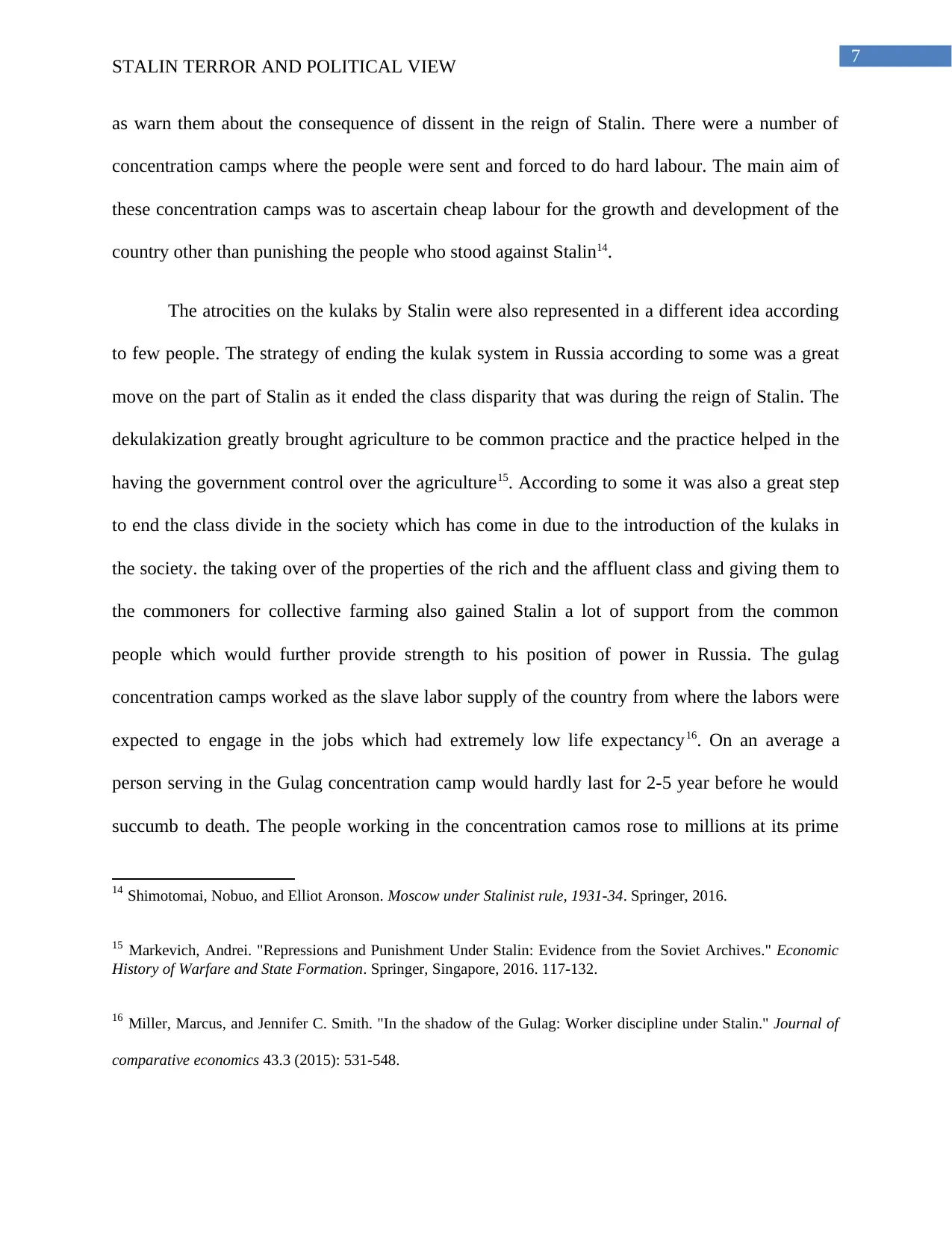
7
STALIN TERROR AND POLITICAL VIEW
as warn them about the consequence of dissent in the reign of Stalin. There were a number of
concentration camps where the people were sent and forced to do hard labour. The main aim of
these concentration camps was to ascertain cheap labour for the growth and development of the
country other than punishing the people who stood against Stalin14.
The atrocities on the kulaks by Stalin were also represented in a different idea according
to few people. The strategy of ending the kulak system in Russia according to some was a great
move on the part of Stalin as it ended the class disparity that was during the reign of Stalin. The
dekulakization greatly brought agriculture to be common practice and the practice helped in the
having the government control over the agriculture15. According to some it was also a great step
to end the class divide in the society which has come in due to the introduction of the kulaks in
the society. the taking over of the properties of the rich and the affluent class and giving them to
the commoners for collective farming also gained Stalin a lot of support from the common
people which would further provide strength to his position of power in Russia. The gulag
concentration camps worked as the slave labor supply of the country from where the labors were
expected to engage in the jobs which had extremely low life expectancy16. On an average a
person serving in the Gulag concentration camp would hardly last for 2-5 year before he would
succumb to death. The people working in the concentration camos rose to millions at its prime
14 Shimotomai, Nobuo, and Elliot Aronson. Moscow under Stalinist rule, 1931-34. Springer, 2016.
15 Markevich, Andrei. "Repressions and Punishment Under Stalin: Evidence from the Soviet Archives." Economic
History of Warfare and State Formation. Springer, Singapore, 2016. 117-132.
16 Miller, Marcus, and Jennifer C. Smith. "In the shadow of the Gulag: Worker discipline under Stalin." Journal of
comparative economics 43.3 (2015): 531-548.
STALIN TERROR AND POLITICAL VIEW
as warn them about the consequence of dissent in the reign of Stalin. There were a number of
concentration camps where the people were sent and forced to do hard labour. The main aim of
these concentration camps was to ascertain cheap labour for the growth and development of the
country other than punishing the people who stood against Stalin14.
The atrocities on the kulaks by Stalin were also represented in a different idea according
to few people. The strategy of ending the kulak system in Russia according to some was a great
move on the part of Stalin as it ended the class disparity that was during the reign of Stalin. The
dekulakization greatly brought agriculture to be common practice and the practice helped in the
having the government control over the agriculture15. According to some it was also a great step
to end the class divide in the society which has come in due to the introduction of the kulaks in
the society. the taking over of the properties of the rich and the affluent class and giving them to
the commoners for collective farming also gained Stalin a lot of support from the common
people which would further provide strength to his position of power in Russia. The gulag
concentration camps worked as the slave labor supply of the country from where the labors were
expected to engage in the jobs which had extremely low life expectancy16. On an average a
person serving in the Gulag concentration camp would hardly last for 2-5 year before he would
succumb to death. The people working in the concentration camos rose to millions at its prime
14 Shimotomai, Nobuo, and Elliot Aronson. Moscow under Stalinist rule, 1931-34. Springer, 2016.
15 Markevich, Andrei. "Repressions and Punishment Under Stalin: Evidence from the Soviet Archives." Economic
History of Warfare and State Formation. Springer, Singapore, 2016. 117-132.
16 Miller, Marcus, and Jennifer C. Smith. "In the shadow of the Gulag: Worker discipline under Stalin." Journal of
comparative economics 43.3 (2015): 531-548.
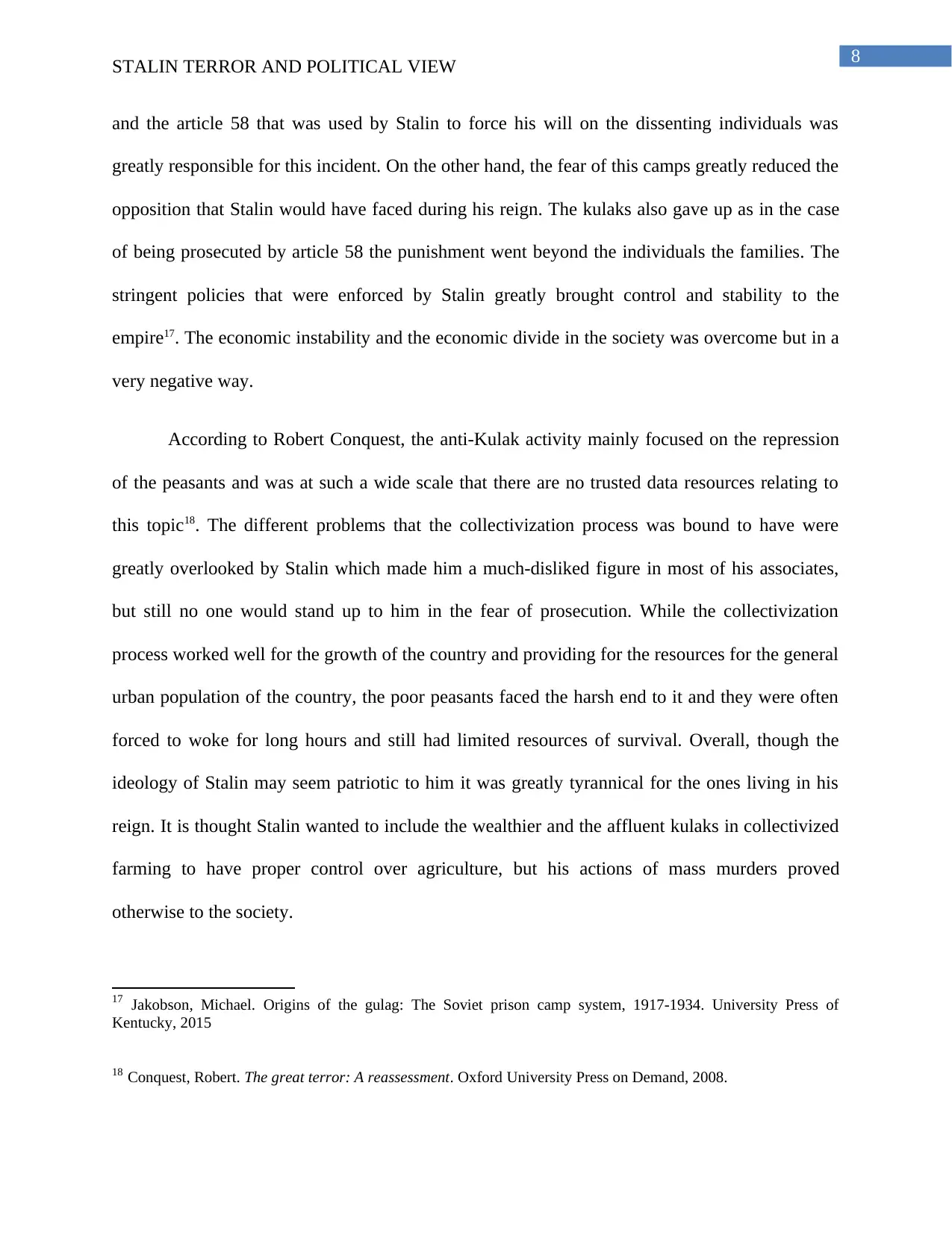
8
STALIN TERROR AND POLITICAL VIEW
and the article 58 that was used by Stalin to force his will on the dissenting individuals was
greatly responsible for this incident. On the other hand, the fear of this camps greatly reduced the
opposition that Stalin would have faced during his reign. The kulaks also gave up as in the case
of being prosecuted by article 58 the punishment went beyond the individuals the families. The
stringent policies that were enforced by Stalin greatly brought control and stability to the
empire17. The economic instability and the economic divide in the society was overcome but in a
very negative way.
According to Robert Conquest, the anti-Kulak activity mainly focused on the repression
of the peasants and was at such a wide scale that there are no trusted data resources relating to
this topic18. The different problems that the collectivization process was bound to have were
greatly overlooked by Stalin which made him a much-disliked figure in most of his associates,
but still no one would stand up to him in the fear of prosecution. While the collectivization
process worked well for the growth of the country and providing for the resources for the general
urban population of the country, the poor peasants faced the harsh end to it and they were often
forced to woke for long hours and still had limited resources of survival. Overall, though the
ideology of Stalin may seem patriotic to him it was greatly tyrannical for the ones living in his
reign. It is thought Stalin wanted to include the wealthier and the affluent kulaks in collectivized
farming to have proper control over agriculture, but his actions of mass murders proved
otherwise to the society.
17 Jakobson, Michael. Origins of the gulag: The Soviet prison camp system, 1917-1934. University Press of
Kentucky, 2015
18 Conquest, Robert. The great terror: A reassessment. Oxford University Press on Demand, 2008.
STALIN TERROR AND POLITICAL VIEW
and the article 58 that was used by Stalin to force his will on the dissenting individuals was
greatly responsible for this incident. On the other hand, the fear of this camps greatly reduced the
opposition that Stalin would have faced during his reign. The kulaks also gave up as in the case
of being prosecuted by article 58 the punishment went beyond the individuals the families. The
stringent policies that were enforced by Stalin greatly brought control and stability to the
empire17. The economic instability and the economic divide in the society was overcome but in a
very negative way.
According to Robert Conquest, the anti-Kulak activity mainly focused on the repression
of the peasants and was at such a wide scale that there are no trusted data resources relating to
this topic18. The different problems that the collectivization process was bound to have were
greatly overlooked by Stalin which made him a much-disliked figure in most of his associates,
but still no one would stand up to him in the fear of prosecution. While the collectivization
process worked well for the growth of the country and providing for the resources for the general
urban population of the country, the poor peasants faced the harsh end to it and they were often
forced to woke for long hours and still had limited resources of survival. Overall, though the
ideology of Stalin may seem patriotic to him it was greatly tyrannical for the ones living in his
reign. It is thought Stalin wanted to include the wealthier and the affluent kulaks in collectivized
farming to have proper control over agriculture, but his actions of mass murders proved
otherwise to the society.
17 Jakobson, Michael. Origins of the gulag: The Soviet prison camp system, 1917-1934. University Press of
Kentucky, 2015
18 Conquest, Robert. The great terror: A reassessment. Oxford University Press on Demand, 2008.
⊘ This is a preview!⊘
Do you want full access?
Subscribe today to unlock all pages.

Trusted by 1+ million students worldwide
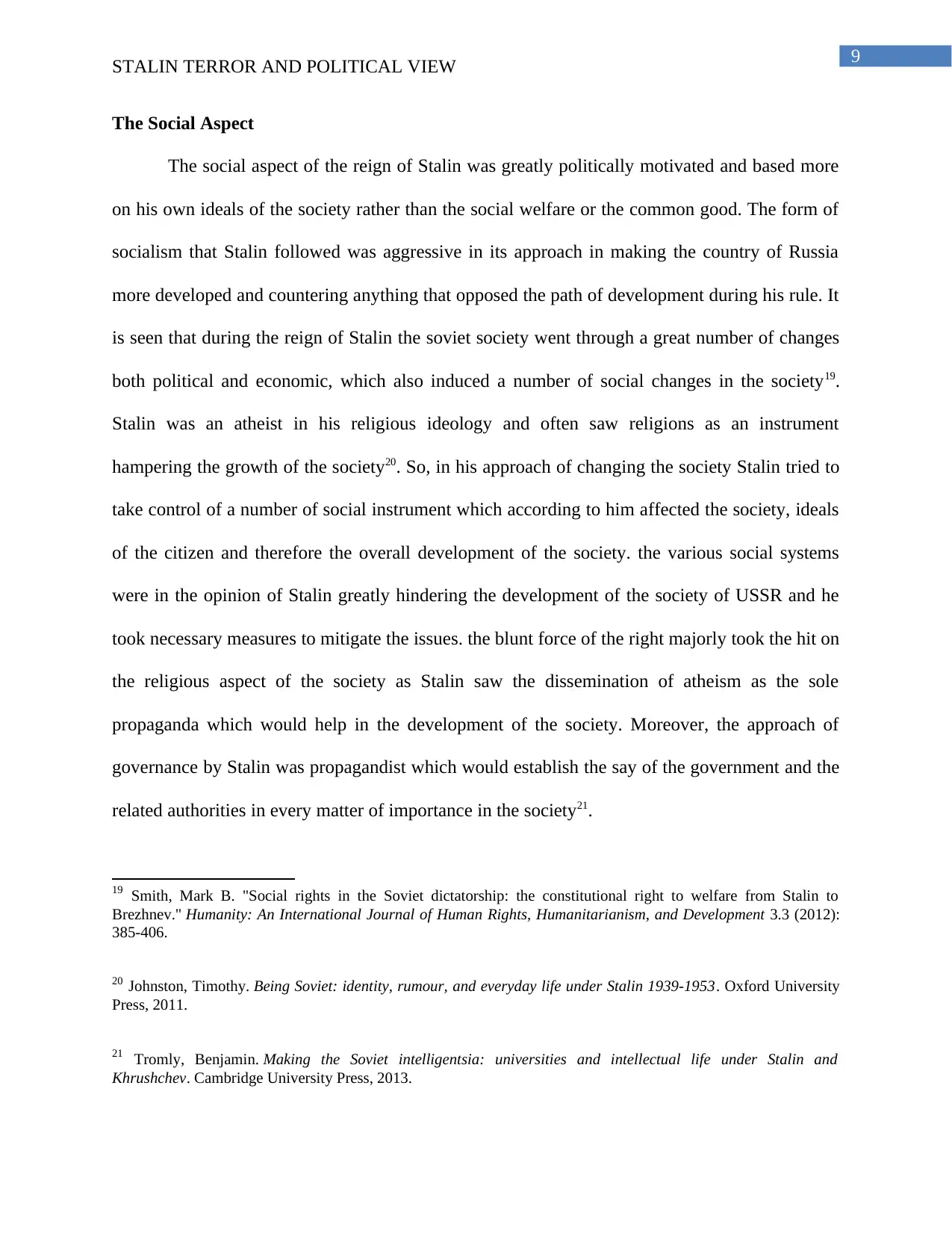
9
STALIN TERROR AND POLITICAL VIEW
The Social Aspect
The social aspect of the reign of Stalin was greatly politically motivated and based more
on his own ideals of the society rather than the social welfare or the common good. The form of
socialism that Stalin followed was aggressive in its approach in making the country of Russia
more developed and countering anything that opposed the path of development during his rule. It
is seen that during the reign of Stalin the soviet society went through a great number of changes
both political and economic, which also induced a number of social changes in the society19.
Stalin was an atheist in his religious ideology and often saw religions as an instrument
hampering the growth of the society20. So, in his approach of changing the society Stalin tried to
take control of a number of social instrument which according to him affected the society, ideals
of the citizen and therefore the overall development of the society. the various social systems
were in the opinion of Stalin greatly hindering the development of the society of USSR and he
took necessary measures to mitigate the issues. the blunt force of the right majorly took the hit on
the religious aspect of the society as Stalin saw the dissemination of atheism as the sole
propaganda which would help in the development of the society. Moreover, the approach of
governance by Stalin was propagandist which would establish the say of the government and the
related authorities in every matter of importance in the society21.
19 Smith, Mark B. "Social rights in the Soviet dictatorship: the constitutional right to welfare from Stalin to
Brezhnev." Humanity: An International Journal of Human Rights, Humanitarianism, and Development 3.3 (2012):
385-406.
20 Johnston, Timothy. Being Soviet: identity, rumour, and everyday life under Stalin 1939-1953. Oxford University
Press, 2011.
21 Tromly, Benjamin. Making the Soviet intelligentsia: universities and intellectual life under Stalin and
Khrushchev. Cambridge University Press, 2013.
STALIN TERROR AND POLITICAL VIEW
The Social Aspect
The social aspect of the reign of Stalin was greatly politically motivated and based more
on his own ideals of the society rather than the social welfare or the common good. The form of
socialism that Stalin followed was aggressive in its approach in making the country of Russia
more developed and countering anything that opposed the path of development during his rule. It
is seen that during the reign of Stalin the soviet society went through a great number of changes
both political and economic, which also induced a number of social changes in the society19.
Stalin was an atheist in his religious ideology and often saw religions as an instrument
hampering the growth of the society20. So, in his approach of changing the society Stalin tried to
take control of a number of social instrument which according to him affected the society, ideals
of the citizen and therefore the overall development of the society. the various social systems
were in the opinion of Stalin greatly hindering the development of the society of USSR and he
took necessary measures to mitigate the issues. the blunt force of the right majorly took the hit on
the religious aspect of the society as Stalin saw the dissemination of atheism as the sole
propaganda which would help in the development of the society. Moreover, the approach of
governance by Stalin was propagandist which would establish the say of the government and the
related authorities in every matter of importance in the society21.
19 Smith, Mark B. "Social rights in the Soviet dictatorship: the constitutional right to welfare from Stalin to
Brezhnev." Humanity: An International Journal of Human Rights, Humanitarianism, and Development 3.3 (2012):
385-406.
20 Johnston, Timothy. Being Soviet: identity, rumour, and everyday life under Stalin 1939-1953. Oxford University
Press, 2011.
21 Tromly, Benjamin. Making the Soviet intelligentsia: universities and intellectual life under Stalin and
Khrushchev. Cambridge University Press, 2013.
Paraphrase This Document
Need a fresh take? Get an instant paraphrase of this document with our AI Paraphraser
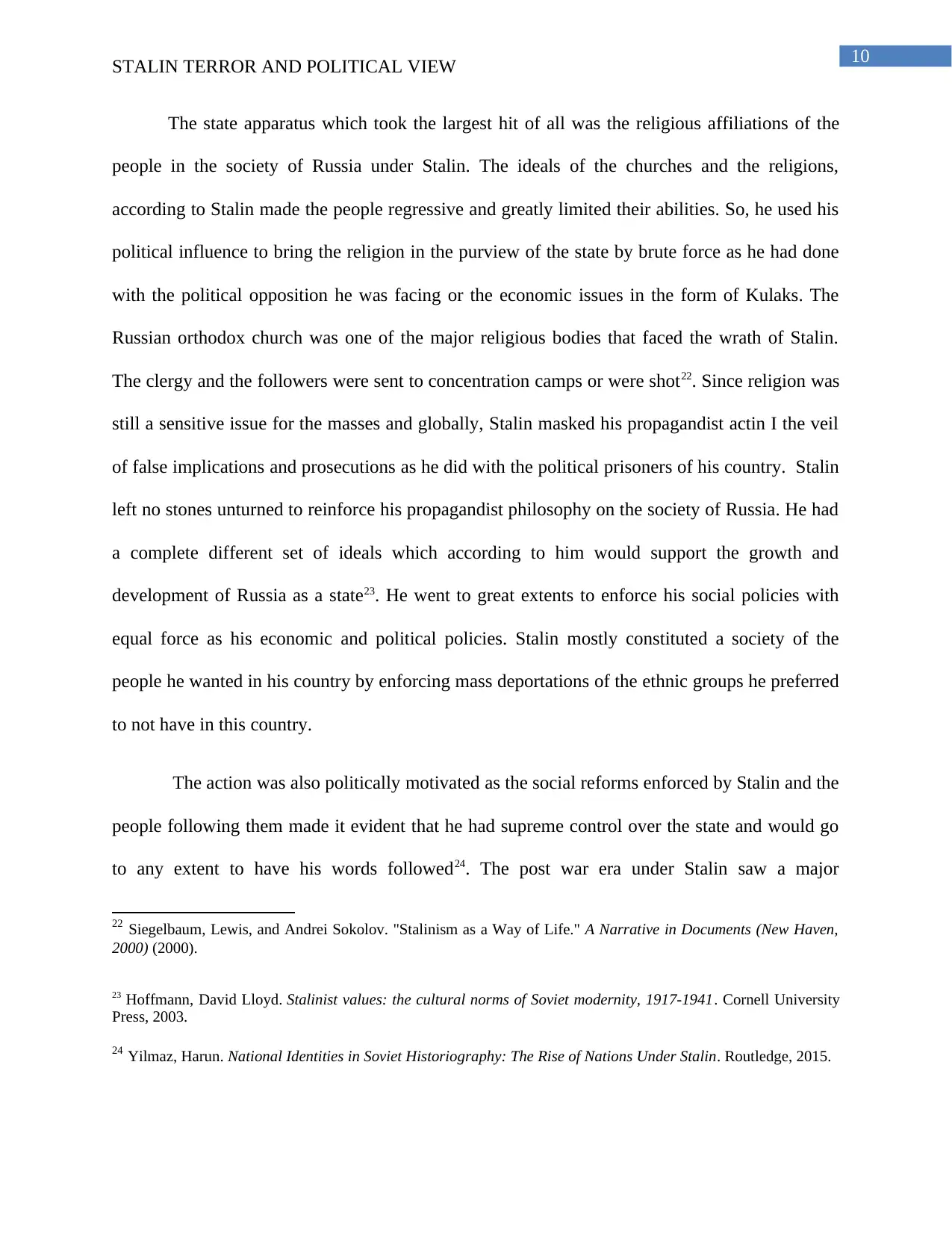
10
STALIN TERROR AND POLITICAL VIEW
The state apparatus which took the largest hit of all was the religious affiliations of the
people in the society of Russia under Stalin. The ideals of the churches and the religions,
according to Stalin made the people regressive and greatly limited their abilities. So, he used his
political influence to bring the religion in the purview of the state by brute force as he had done
with the political opposition he was facing or the economic issues in the form of Kulaks. The
Russian orthodox church was one of the major religious bodies that faced the wrath of Stalin.
The clergy and the followers were sent to concentration camps or were shot22. Since religion was
still a sensitive issue for the masses and globally, Stalin masked his propagandist actin I the veil
of false implications and prosecutions as he did with the political prisoners of his country. Stalin
left no stones unturned to reinforce his propagandist philosophy on the society of Russia. He had
a complete different set of ideals which according to him would support the growth and
development of Russia as a state23. He went to great extents to enforce his social policies with
equal force as his economic and political policies. Stalin mostly constituted a society of the
people he wanted in his country by enforcing mass deportations of the ethnic groups he preferred
to not have in this country.
The action was also politically motivated as the social reforms enforced by Stalin and the
people following them made it evident that he had supreme control over the state and would go
to any extent to have his words followed24. The post war era under Stalin saw a major
22 Siegelbaum, Lewis, and Andrei Sokolov. "Stalinism as a Way of Life." A Narrative in Documents (New Haven,
2000) (2000).
23 Hoffmann, David Lloyd. Stalinist values: the cultural norms of Soviet modernity, 1917-1941. Cornell University
Press, 2003.
24 Yilmaz, Harun. National Identities in Soviet Historiography: The Rise of Nations Under Stalin. Routledge, 2015.
STALIN TERROR AND POLITICAL VIEW
The state apparatus which took the largest hit of all was the religious affiliations of the
people in the society of Russia under Stalin. The ideals of the churches and the religions,
according to Stalin made the people regressive and greatly limited their abilities. So, he used his
political influence to bring the religion in the purview of the state by brute force as he had done
with the political opposition he was facing or the economic issues in the form of Kulaks. The
Russian orthodox church was one of the major religious bodies that faced the wrath of Stalin.
The clergy and the followers were sent to concentration camps or were shot22. Since religion was
still a sensitive issue for the masses and globally, Stalin masked his propagandist actin I the veil
of false implications and prosecutions as he did with the political prisoners of his country. Stalin
left no stones unturned to reinforce his propagandist philosophy on the society of Russia. He had
a complete different set of ideals which according to him would support the growth and
development of Russia as a state23. He went to great extents to enforce his social policies with
equal force as his economic and political policies. Stalin mostly constituted a society of the
people he wanted in his country by enforcing mass deportations of the ethnic groups he preferred
to not have in this country.
The action was also politically motivated as the social reforms enforced by Stalin and the
people following them made it evident that he had supreme control over the state and would go
to any extent to have his words followed24. The post war era under Stalin saw a major
22 Siegelbaum, Lewis, and Andrei Sokolov. "Stalinism as a Way of Life." A Narrative in Documents (New Haven,
2000) (2000).
23 Hoffmann, David Lloyd. Stalinist values: the cultural norms of Soviet modernity, 1917-1941. Cornell University
Press, 2003.
24 Yilmaz, Harun. National Identities in Soviet Historiography: The Rise of Nations Under Stalin. Routledge, 2015.
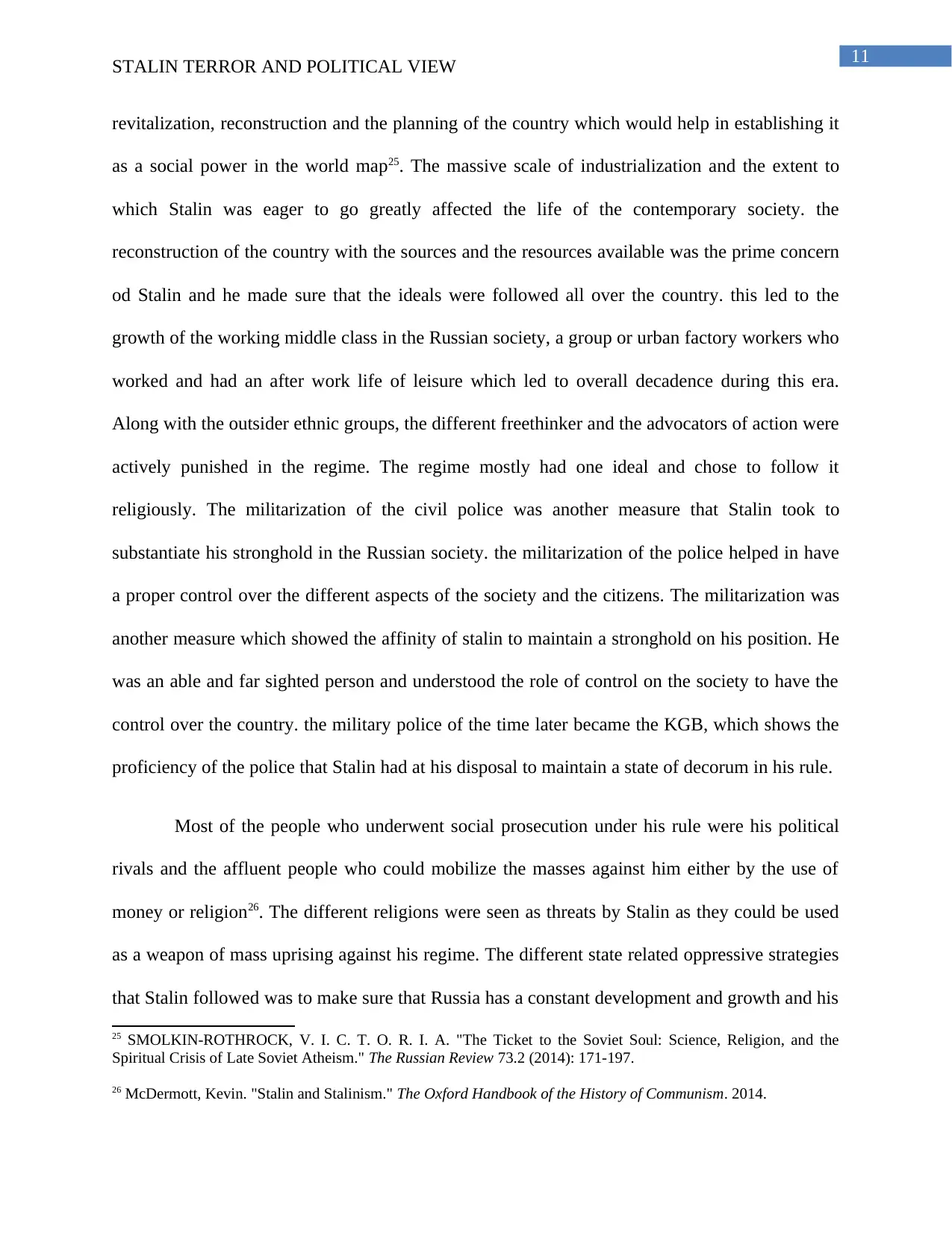
11
STALIN TERROR AND POLITICAL VIEW
revitalization, reconstruction and the planning of the country which would help in establishing it
as a social power in the world map25. The massive scale of industrialization and the extent to
which Stalin was eager to go greatly affected the life of the contemporary society. the
reconstruction of the country with the sources and the resources available was the prime concern
od Stalin and he made sure that the ideals were followed all over the country. this led to the
growth of the working middle class in the Russian society, a group or urban factory workers who
worked and had an after work life of leisure which led to overall decadence during this era.
Along with the outsider ethnic groups, the different freethinker and the advocators of action were
actively punished in the regime. The regime mostly had one ideal and chose to follow it
religiously. The militarization of the civil police was another measure that Stalin took to
substantiate his stronghold in the Russian society. the militarization of the police helped in have
a proper control over the different aspects of the society and the citizens. The militarization was
another measure which showed the affinity of stalin to maintain a stronghold on his position. He
was an able and far sighted person and understood the role of control on the society to have the
control over the country. the military police of the time later became the KGB, which shows the
proficiency of the police that Stalin had at his disposal to maintain a state of decorum in his rule.
Most of the people who underwent social prosecution under his rule were his political
rivals and the affluent people who could mobilize the masses against him either by the use of
money or religion26. The different religions were seen as threats by Stalin as they could be used
as a weapon of mass uprising against his regime. The different state related oppressive strategies
that Stalin followed was to make sure that Russia has a constant development and growth and his
25 SMOLKIN‐ROTHROCK, V. I. C. T. O. R. I. A. "The Ticket to the Soviet Soul: Science, Religion, and the
Spiritual Crisis of Late Soviet Atheism." The Russian Review 73.2 (2014): 171-197.
26 McDermott, Kevin. "Stalin and Stalinism." The Oxford Handbook of the History of Communism. 2014.
STALIN TERROR AND POLITICAL VIEW
revitalization, reconstruction and the planning of the country which would help in establishing it
as a social power in the world map25. The massive scale of industrialization and the extent to
which Stalin was eager to go greatly affected the life of the contemporary society. the
reconstruction of the country with the sources and the resources available was the prime concern
od Stalin and he made sure that the ideals were followed all over the country. this led to the
growth of the working middle class in the Russian society, a group or urban factory workers who
worked and had an after work life of leisure which led to overall decadence during this era.
Along with the outsider ethnic groups, the different freethinker and the advocators of action were
actively punished in the regime. The regime mostly had one ideal and chose to follow it
religiously. The militarization of the civil police was another measure that Stalin took to
substantiate his stronghold in the Russian society. the militarization of the police helped in have
a proper control over the different aspects of the society and the citizens. The militarization was
another measure which showed the affinity of stalin to maintain a stronghold on his position. He
was an able and far sighted person and understood the role of control on the society to have the
control over the country. the military police of the time later became the KGB, which shows the
proficiency of the police that Stalin had at his disposal to maintain a state of decorum in his rule.
Most of the people who underwent social prosecution under his rule were his political
rivals and the affluent people who could mobilize the masses against him either by the use of
money or religion26. The different religions were seen as threats by Stalin as they could be used
as a weapon of mass uprising against his regime. The different state related oppressive strategies
that Stalin followed was to make sure that Russia has a constant development and growth and his
25 SMOLKIN‐ROTHROCK, V. I. C. T. O. R. I. A. "The Ticket to the Soviet Soul: Science, Religion, and the
Spiritual Crisis of Late Soviet Atheism." The Russian Review 73.2 (2014): 171-197.
26 McDermott, Kevin. "Stalin and Stalinism." The Oxford Handbook of the History of Communism. 2014.
⊘ This is a preview!⊘
Do you want full access?
Subscribe today to unlock all pages.

Trusted by 1+ million students worldwide
1 out of 17
Related Documents
Your All-in-One AI-Powered Toolkit for Academic Success.
+13062052269
info@desklib.com
Available 24*7 on WhatsApp / Email
![[object Object]](/_next/static/media/star-bottom.7253800d.svg)
Unlock your academic potential
Copyright © 2020–2025 A2Z Services. All Rights Reserved. Developed and managed by ZUCOL.





